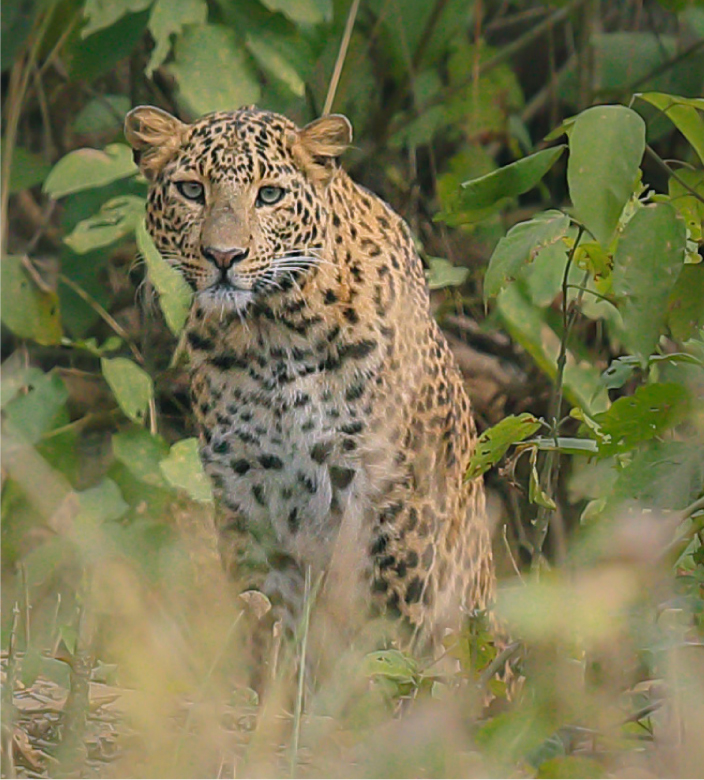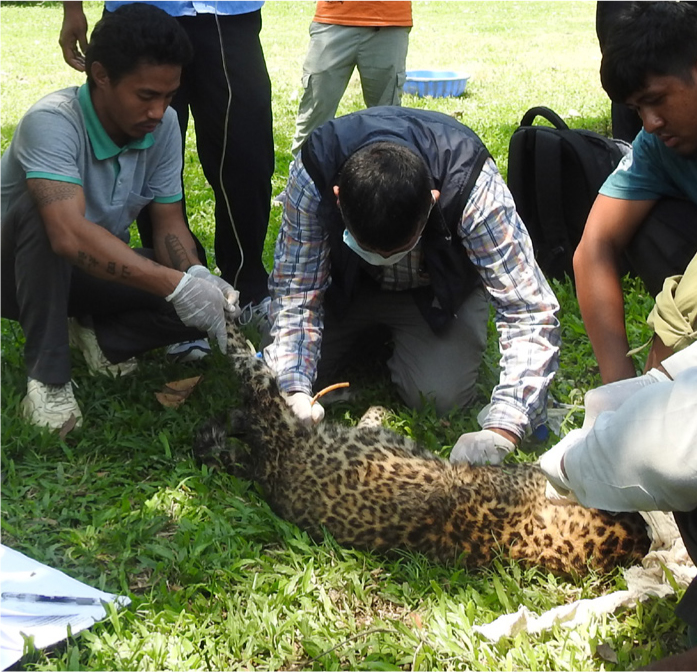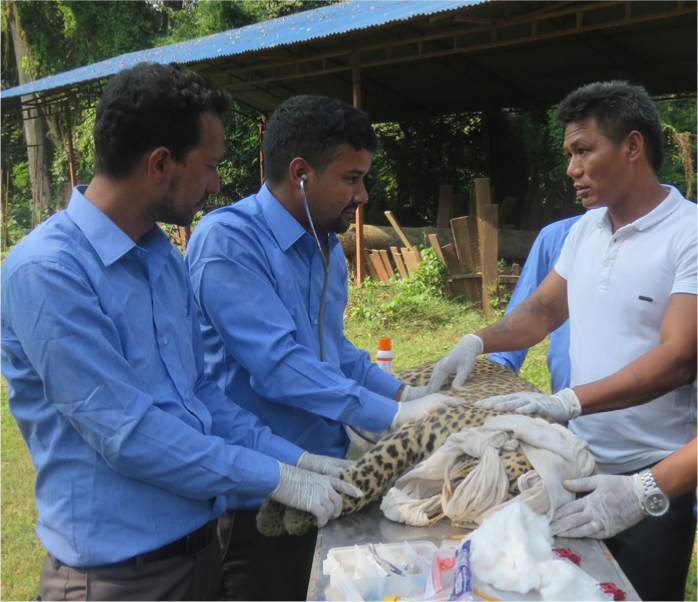In the UK, when we think of leopards we typically think of days out at the zoo and exotic safaris, but for the people liv-ing alongside these animals it can be a very different story. In rural Nepal, people and leopards live in close proximity and encounters are common. In some cases, this might mean the loss of a goat or a prized family pet, but in others, the consequences are far worse. In 2021, Wildlife Vets International (WVI) plans to support a project dedicated to investigating the health status of so-called ‘conflict leopards’. It is hoped that a better understanding of the condition of these animals will provide further insights into the forces driving conflict and inform the way future incidents are managed.
Situated in South Asia, Nepal is a country of extremes. The north of the country runs along the spine of the Himalayas and is home to some of the world's tallest mountains. These descend through the fertile valleys of the mid-hills, to the tropical forests and grasslands of the Terai plains. This rich and varied landscape has an abundance of wildlife, but not all of its inhabitants make good neighbours. From 2010 to 2014, there were an average of 19 leopard at-tacks on people each year. These incidents fre-quently take place outside protected areas and, tragically, often involve children. Over 40% of attacks prove fatal. It is easy to understand how losses like these could incite anger, violence and retaliatory killing, and in many countries this is the case, with persecution of leopards remaining one of the biggest threats to their survival. However, in Nepal which takes pride in its wildlife, government agencies and local NGOs are working hard to manage the situa-tion and find long-term solutions.
One such organisation is the National Trust for Nature Conservation (NTNC), which was founded in 1982 as an autonomous, not-for-profit organisation with a mandate for nature conservation in Nepal. The NTNC was in-strumental in establishing Nepal's first wild-life hospital. This is a truly ground-breaking achievement which has been realised, in no small part, thanks to the continued efforts of Dr Amir Sadaula, head vet at the NTNC Biodi-versity Conservation Center, based in Chitwan National Park. ‘Without the necessary facili-ties it is difficult to do good work,’ Dr Sadaula said. ‘This is why, since joining NTNC, I have worked so hard to develop our capacity; first establishing our in-house laboratory and more recently building the hospital. Any work for wildlife is always a team effort and we have been fortunate enough to receive support from both the Nepali government and colleagues abroad.' WVI was proud to be able to lend support with a fundraising campaign, when the veterinary department faced redundancies and closure because of the Covid-19.

Dr Sadaula's team is heavily involved in the management of human-wildlife conflict, regu-larly responding to incidents to safeguard the public and rescue cornered animals. On one occasion, his team travelled as far as India to recover several rhinos that had been washed across the border with the monsoon floods. In the last year alone, the NTNC has successfully rescued 12 leopards, several of whom required treatment before they could be returned to the wild. Increasingly, these released animals have been fitted with GPS collars, allowing researchers to follow their movements and monitor their progress. However, this kind of technology is expensive and ensuring an ad-equate supply for the diverse species the team are handling can be a challenge.
Conservationists in Nepal are also actively investigating the causes of human-leopard conflict. Shashank Poudel, who grew up in Nepal and worked for the NTNC before re-turning to education, is currently investigat-ing the landscape level patterns and drivers of human-leopard conflict in Nepal for his PhD at Cornell University (USA). His efforts have been hampered by Covid-19 as travel restric-tions were imposed and fieldwork was delayed. However now he is back in the field, working alongside the NTNC, interviewing villagers to learn more about the locations and circum-stances of previous leopard attacks.

Based out of the newly established hospital, the WVI project will complement these existing conservation efforts by focusing on the piece of the puzzle relating to health. Cur-rently little is known about the health status of Nepal's leopards, let alone how it might be linked to conflict. However, it stands to rea-son, that an animal which is malnourished or debilitated in some way might be more likely to accept the risks associated with stealing an easy meal rather than take its chances stalking a healthy wild deer. To investigate this theory, comprehensive health assessments will be car-ried out on all rescued leopards. Particular attention will be paid to factors that could af-fect the animal's ability to defend a territory or hunt wild prey. This will be coupled with in-tensive post-release monitoring to determine which leopards are able to feed themselves and establish and maintain territories, as well as which animals tend to gravitate back to human settlements. These findings will be crucial to informing new management protocols to help identify which leopards are most suitable for release, thus ensuring the safety of local com-munities and the released leopards themselves.
Dr Sadaula's team are highly skilled and motivated, but constantly juggling a myriad of demands, from wildlife rescue to disease investigation. The WVI aims to relieve some of this pressure by providing a dedicated vet-erinarian who will focus on leopard health. WVI vet Jessica Bodgener will work closely with Shashank Poudel, Dr Sadaula and his team at the NTNC but will also shoulder the burden of all the administrative work and data entry, which can be difficult to prioritise when you have a busy case load. Meanwhile, WVI founder and big cat expert, John Lewis will be on hand to provide additional remote support and guidance whenever needed.
An added bonus of the project is the op-portunity for ongoing surveillance on canine distemper virus (CDV) in wild felids. CDV in big cats first hit the headlines in 1994 when an epidemic in Tanzania's Serengeti National Park, resulting in the loss of a third of the resident lion population. In 2003 and 2010 fatal infections were identified in wild Sibe-rian tigers in Russia. Subsequent modelling revealed that for small populations of 25 ti-gers or less, the additive mortality associated with CDV could increase the likelihood of extinction within a 50 year period by more than 65%. This raised concern and prompted a call for wider investigations. For the past three years, Jess has been part of a team which has sought to support these efforts by devel-oping in-country virus neutralisation testing in several tiger range states, including Nepal. Distemper could prove particularly relevant in conflict animals as the later stages of dis-ease can result in neurological disturbances including disorientation, loss of fear and be-haviour change – all of which could lead to conflict. Consequently, all leopards handled within the project will be tested for CDV in-fection and exposure.
Global pandemics aside, the timing of this project could not be better. By the time Shashank has completed his PhD the WVI's health-based investigations will have been up and running for two years, resulting in a wealth of data to draw on. The intention then is to share our findings with others in the field and come together to develop Nepal's first comprehensive policy document for the con-servation of leopards, with special attention on managing conflict: something that would help to secure the future of leopards in Ne-pal for years to come, and could even act as a template for leopard conservation worldwide.


